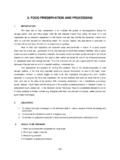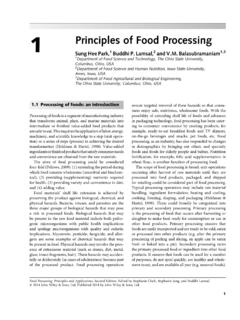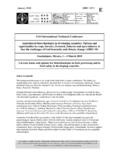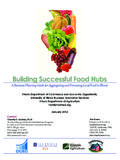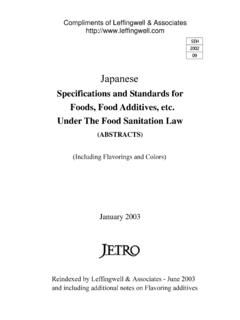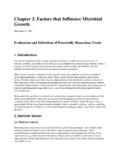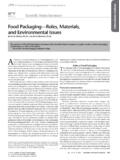Transcription of Small-scale cashew nut processing - Food and …
1 Sur 702006-06-25 17:14 Small-scale cashew nut processing S H Azam-Ali and E C JudgeITDG Schumacher Centre for Technology and Development Bourton on Dunsmore, Rugby, Warwickshire, UK FAO, 2001 ACKNOWLEDGEMENTSThe authors are grateful to M Whitton for providing the would also like to thank the Small-scale cashew processors in Sri Lanka and the participants of the International cashew Workshop "Cashing in on cashew " held in Sri Lanka (November 2000) for sharing vital information on cashew S H Azam-Ali Agro- processing Specialist E C Judge Agro- processing Researcher ITDG Schumacher Centre for Technology and Development Bourton on Dunsmore, Rugby, Warwickshire, CV23 9QZ, UK Contributions from: J Gunasekara Agro- processing Programme Manager ITDG South Asia 5 Lionel Edirisinghe Mawatha, Kirulapone, Colombo 5, Sri sur 702006-06-25 17:14 TABLE OF CONTENTSA cknowledgementsList of FiguresList of TablesList of BoxesChapter 1. The importance of cashew cashew cashew nut shell Opportunities for Small-scale The way aheadChapter 2 cashew Botanical Agricultural practices, propagation and Seasonal Raising seedlings in a Approach-grafting or Land Fertilizer use in Basal dressing at sur 702006-06-25 17 Rate of application of Method of fertilizer Frequency and timing of Drying of the raw Infestation of harvested Post harvest handlingChapter 3 Uses of Uses of cashew Uses of cashew nut shell liquid (CNSL) Uses of cashew Using cashew apples in Dried cashew fruitsChapter 4 Trends in cashew nut production and Global cashew cashew production in Production in Production in Production in Production in other African cashew production in Production in Production in Production in Production in Sri Production in Production in South and Central Production in Global trade International sur 702006-06-25 17.
2 14 Chapter 5 Traditional methods of cashew cashew processing in cashew processing in cashew processing in Traditional processing in Traditional processing in Sri Traditional manual Quality control in Manual peelingChapter 6 cashew processing General Cleaning, sizing and Soaking or Large- scale cleaning and Roasting and Drum The hot oil Mechanical Hygiene and food hygiene and the food poisoning and its Personal Cleanliness of equipment and the working Other sources of sur 702006-06-25 17 Packaging and preservationChapter 7 BibliographyChapter 8 Selected references and contactsPublished sourcesInternet sitesEquipment manufacturers and suppliersOrganizations involved in cashew processingAnnex 1 Trends in global production (1961 to 2000)Annex 2 Products containing cashew apple and cashew nut LIST OF FIGURESF igure 1 2:Inarching 3:Inarching 4:Cross section of a cashew 5:Global cashew production (1961 to 2000) (tonnes).
3 Figure 6:Pan 7:Overview of cashew nut 8:Medium- scale 9:Diagram of a drum roaster fired from a furnace 10: cashew shelling 11: Diagram of a tray dryer. LIST OF TABLEST able : cashew production (tonnes) in African countries from 1961 to :Leading African producers of cashew . Percentage of African and global production (1961 to 2000).Table : cashew production (tonnes) in Asian countries from 1961 to sur 702006-06-25 17:14 Table : cashew production (tonnes) in South and Central American countries from 1961 to 2000. LIST OF BOXESBox :World Bank policy and cashew processing in MozambiqueBox :Critical conditions for the 'hot oil' method of CNSL :Measurement of the moisture content of cashew kernels CHAPTER 1 INTRODUCTIONThe cashew tree, native to Brazil, was introduced to Mozambique and then India in the sixteenth century by thePortuguese, as a means of controlling coastal erosion. It was spread within these countries with the aid of elephants thatate the bright cashew fruit along with the attached nut.
4 The nut was too hard to digest and was later expelled with thedroppings. It was not until the nineteenth century that plantations were developed and the tree then spread to a number ofother countries in Africa, Asia and Latin processing , using manual techniques, was started in India in the first half of the twentieth century. It wasexported from there to the wealthy western markets, particularly the United States. In the 1960s, some of the producingcountries in East Africa began to process nuts domestically rather than sending them to India for processing . Thisallowed them to benefit from the sale of both processed nuts and the extracted cashew nut shell liquid. The importance of cashewCashew is held with great esteem in many customs and cultures. Its value can be estimated from a question that appearedon the household census in Mozambique that asked whether the house owned any cashew is known by many names. In Mozambique, the Maconde tribe refer to it as the "Devil's Nut".
5 It is offered atwedding ceremonies as a token of fertility and is considered by many to have aphrodisiac properties. The cashew tree andits products are known by the following names in other parts of the world:Portuguese caju, cajueiro, pe de caju, castanha de caju, maca de caju French cajou, acajou, ancardier, noix de cajou, pomme de cajou, amande de cajou English cashew , cashew tree, cashew nut, cashew apple, cashew kernel Spanish maranon, nuez de maranon Hindi cadju Sinhalese cadju Italian anacardio, noce d'anacardio, mandorlad'anacardio Dutch acajou, kashu German acajuban, kashunuss Swahili mkanju, korosho Somali bibbo, bibs Indonesian jambu mente, jambu meteSource: Andrighetti et al, (1989). sur 702006-06-25 17:14 The cashew industry ranks third in the world production of edible nuts with world production in 2000 at about 2 milliontonnes of nuts-in-shell and an estimated value in excess of US$2 billion. India and Brazil are the major cashew exporters,with 60 percent and 31 percent respectively of world market share.
6 The major importers are the United States (55percent), the Netherlands (ten percent), Germany (seven percent), Japan (five percent) and the United Kingdom (fivepercent). cashew kernels are ranked as either the second or third most expensive nut traded in the United States. Macadamia nutsare priced higher and pecan nuts can be more costly, if the harvest is poor. cashew nuts have a well established market inthe United States with a great variety of uses. Retail prices range from about US$4 to 11 per pound (US$9 to 23 per kg)depending on the size of nut and the extensive market connections of exporters from Brazil and India make it difficult for the smaller exporters to makegains in the United States market. Importers may appreciate the low prices offered by small suppliers, but the lack ofreliability in quality tends to make them favour the larger, more reputable suppliers (The Clipper, 1994). cashew productsThree main cashew products are traded on the international market: raw nuts, cashew kernels and cashew nut shell liquid(CNSL).
7 A fourth product, the cashew apple is generally processed and consumed raw cashew nut is the main commercial product of the cashew tree, though yields of the cashew apple are eight to tentimes the weight of the raw nuts. Raw nuts are either exported or processed prior to export. processing of the raw nutsreleases the by-product CNSL that has industrial and medicinal applications. The skin of the nut is high in tannins andcan be recovered and used in the tanning of hides. The fruit of the cashew tree that surrounds the kernel can be made intoa juice with a high vitamin C content and fermented to give a high proof spirit. cashew kernelsIt is estimated that 60 percent of cashew kernels are consumed in the form of snacks while the remaining 40 percent areincluded in confectionery. The cashew competes in the same market as other edible nuts including almonds, hazels,walnuts, pecans, macadamias, pistachios and peanuts. There has recently been a considerable rise in demand for ediblenuts by consumers interested in quality and health aspects of food .
8 The breakfast cereal, health food , salads and bakedgoods markets are all expanding markets for cashew major factor that affects the consumption of cashew kernels in world markets is competition from other tree major importers in developed countries contract their requirement for the whole year based on the sales fromprevious years. If prices of a commodity fluctuate over a wide range, they will not want to trade in that item for fear ofincurring heavy losses. Since cashew cultivation is not organized on a plantation scale in most producing countries, yearto year variation in crop yield is a regular feature resulting in wide price fluctuations for cashew kernels. On the otherhand, almonds and pistachios are grown in very large plantations in the United States and thus their prices are steady yearafter year (Nayar, 1995). cashew nut shell liquidCashew nut processing allows for the development of an important by-product, which can increase its added value.
9 Theliquid inside the shell (CNSL) represents 15 percent of the gross weight and has some attractive possible medicinal andindustrial uses. CNSL is one of the few natural resins that is highly heat resistant and is used in braking systems and inpaint manufacture. It contains a compound known as anacardium, which is used to treat dermatological disorders. Themain markets for CNSL are the United States, the European Union (mainly the United Kingdom), Japan and the Republicof Korea. Together these account for over ninety percent of world trade, most of which is supplied by India and Brazil. ProcessingTraditionally the various processing operations were performed manually by experienced semi-skilled workers. This isstill the case in India, which is the world' s largest producer of cashew kernels. Since the 1960s, various sur 702006-06-25 17:14pieces of equipment have been developed and are available in several countries. The processes that have beenmechanized are roasting, cashew nut shell liquid extraction and shelling.
10 For the most part, the cleaning of raw materialsand sizing and kernel grading have remained labour intensive manual are significant differences in investment requirements, labour skills, health requirements and levels of efficiencybetween the Indian manual technology and the medium to large- scale mechanical and semi-mechanical operations. Ingeneral the Indian processing system involves lower investment and variable costs and achieves far greater efficiency interms of kernel material yield and the proportion of whole kernels extracted. However this system requires large numbersof experienced workers who work at unhealthy levels of exposure to CNSL. The mechanized systems are morevulnerable to breakdown due to shortage of spare parts, require large volumes of nuts for efficient operation and operatewell below manufacture specifications when strict grading and sizing activities are not in place prior to shelling (Jaffeeand Morton, 1995).










